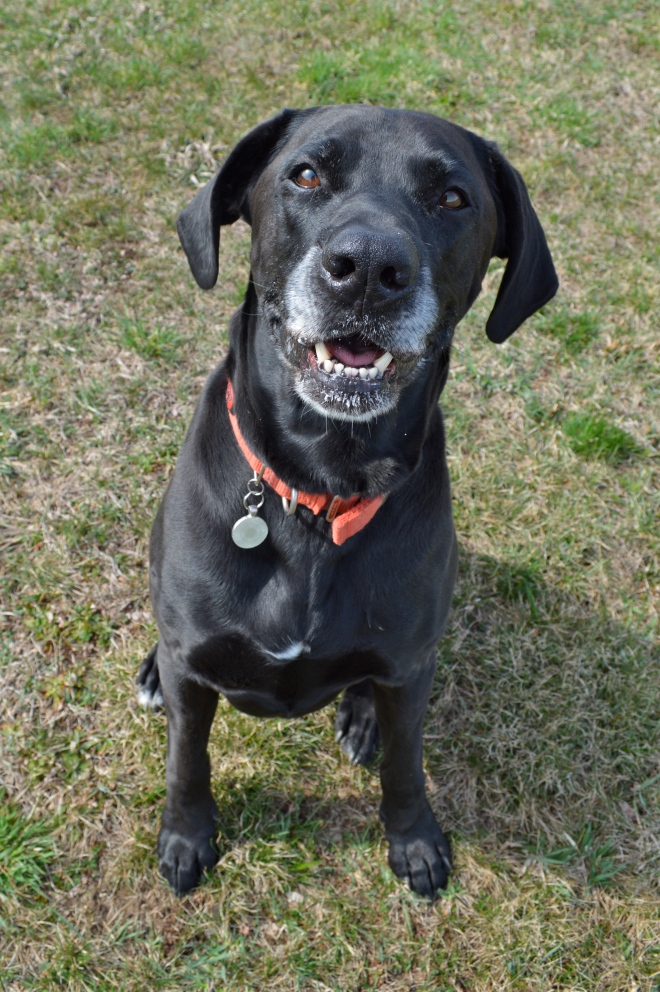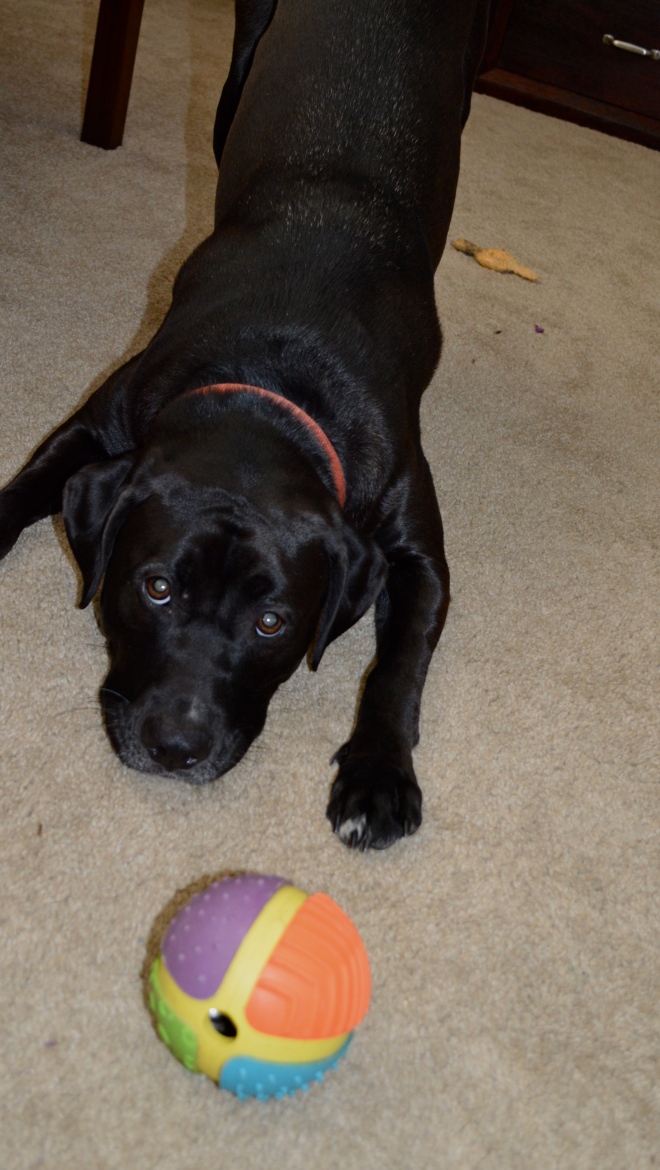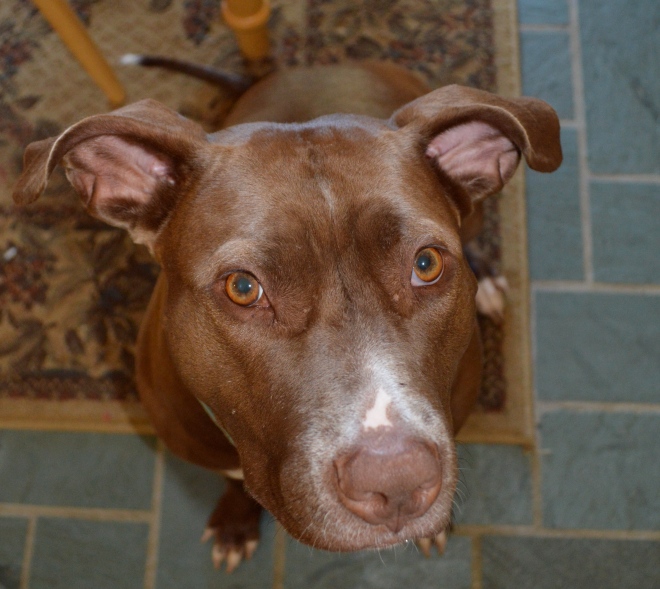My approach to dog training is not altogether different from my approach to my human relationships. Because that is what my interactions with dogs are… relationships. You must give love (or kindness, or respect, etc), to receive it in return, and you must be more focused on what you put in than you are on what you receive. This approach largely explains why I believe that force-free dog training is the best way.

Tonka loves to learn!
Relationship Reinforcing
I fully recognize that a more heavy-handed approach is still very much prevalent in our society. Why? Because of Caesar Milan. Because it works. A dog is afraid of punishment, afraid of pain, afraid of the one in charge, so they operate in whatever way necessary to avoid these things. Science has proven that these approaches do not work long-term in real-life, but they do produce results of indeterminate length or consistency. Using punishment to stop behaviors is nothing new. But notice, I use the word ‘stop‘, as opposed to the word ‘teach‘. We can stop any behavior, but I am more interested in teaching my dogs to choose the behavior I seek. If we utilize intimidation and physical punishment, have we truly stopped the underlying behavior issue, or simply made our dog fearful of our reactions to their instincts? I never force, but I always give my dogs a choice, or at least the illusion of such. They make the right choice because they trust me, because I do not hurt them, because I keep them safe, because I make it easier than the wrong, and because the outcome is enjoyable. They make this choice because while training, we establish a relationship and a partnership. They do not just aim to avoid pain… they aim to please.

Even a game of fetch should have fun rules… consider them bargaining points!
Training Across the Species
Some of you may know that I am as active in horse training as I am in dog training. One thing that is important to remember is that appropriate training practices should be able to be applied successfully to any species, at least as far as your approach and methodology. Do we want to have to rely on disciplining a large or dangerous animal when they have displayed a poor behavior? Of course not, because it might be too late! It might also result in frustration on the part of the animal, which can lead to aggression. Instead, we as the trainer need to be managing the situation and environment during our training sessions in order to avoid the occurrence of the bad behavior in the first place. When in doubt, ask yourself… would I want to tell my horse “No”? What about my elephant or my tiger?!
Pets as Robots?
Punishment-based methods can work. In the right settings and with uniquely tempered dogs, they can produce animals that respond quickly and correctly. In effect, they produce animals that perform. If we train our dogs like machines, with cold punishment and little reward, they will operate in like fashion… with detachment and avoidance. What those methods cannot do, is contribute to building relationships. And why do dogs exist in our lives, if not to be our family members and friends, guardians and partners, cuddlers and playmates? Rather, if we embrace the natural abilities and traits of our dogs as individuals or as a species, we will create a partnership with a free-willed and independent animal who chooses to do anything in its power to please us. And that is more powerful to me than any other force.
No Effort Dog Training… What?!
While food can be a fantastic motivator to many dogs, it is certainly not the only one. My favorite reward to use with my own dogs are non-food reinforcers, or functional rewards. This allows the dog to tell us what their preferred reward would be. Have a reactive dog who likes to approach other dogs rudely while on a walk? (Provided that the reactivity is not fear-based…) Don’t allow the dog to move toward their trigger unless they are calm and quiet. This approach is used commonly as a parenting practice: you want your teenager to clean their room, and it is a regular battle. Once you find their functional reward (they want to go to the movies with their friends) you prevent them from achieving their reward (movie) until they have performed the desired behavior (cleaning). Make sense? This type of functional training is especially effective, because it doesn’t require you setting aside time for obedience, getting out the clicker and treats, setting up the environment, etc. While that is productive, it isn’t something that the average owner makes time for each day. Functional training is something that is simple to apply in your daily life and schedule, and will directly equate to a dog who is a more compatible addition to your family’s lifestyle, because you use everyday scenarios to improve your dog’s behavior.
By recognizing and utilizing your dogs’ natural behaviors, traits, and preferences, you can be a step ahead in your training. Exploit the fact that your dog’s life is full of rewards! Think of all the pleasurable activities you control access to, and use them to help your dog earn his rewards by displaying good behavior. For example, have a dog who loves to play fetch? Require every session to be a training opportunity. Before the ball is thrown, they must sit, and before it is taken, they must come when called and ‘drop it’ on command. If they fail to respond appropriately, the play session ends. Proper obedience doesn’t always have to take place in formal classes or structured sessions… it can (and should!) be as simple as incorporating cues and rewards into your everyday routines.

Georgia has learned to ‘offer’ a sit when she is in doubt as to what is expected of her
Offering Behavior
Think about traditional dog training. The handler verbalizes a ‘command,’ perhaps coupled with a a hand motion. The dog is then supposed to reply with the corresponding behavior. The problem with this, is these training sessions do not always automatically relay to our everyday lives. For example, we want our dogs to sit for attention when guests come into our home, but how do we ‘train’ this in a traditional obedience session? As you are greeting your guests, do you want to also have to command your dog to sit amidst the confusion? To your dog, these are two entirely different scenarios, and the application may not be evident. If we teach our dogs through everyday interactions to ‘offer’ behaviors without a command, and withhold their functional reward until they do so, we are more likely to see these behaviors relayed in everyday events. Remember, dogs are functional beings, and they repeat what works. The dog has learned that jumping and barking = being ignored, while sitting quietly = praise and attention, and so they will repeat it, even in the presence of guests (just make sure your guests are ‘trained’ as well!)
Have confidence in the cognitive abilities of your pup… once you have successfully requested the desired behavior a few times, approach the next session with the goal that you will try to let them figure it out before jumping in and making commands. This gives your dog a chance to demonstrate what you’ve taught them, and teaches them to use their brains to solve the puzzle, by independent figuring out how to appropriately get whatever it is that they desire.
It is important to remember that if we punish our dogs for inappropriate behavior, they are going to be less likely to want to try to offer a behavior on their own. This technique requires a dog who is balanced and confident in his or her relationship with you as the owner or handler, and will never work in conjunction with forceful training practices.
Application
Today’s challenge is to focus on one area of your dog’s behavior that is particularly frustrating. Instead of correcting them when they display an inappropriate behavior, make a choice not to allow them the opportunity to act poorly in the first place, and then focus on the reward. Try to allow them to offer the behavior without making the request. Have a dog that rushes past you through doors, or is pushy during feeding time? Their reward is as simple as the thing that they seek, which makes your job very easy! Withhold the ‘reward’ until they have offered an appropriate behavior, such as a sit. Having a dog with good manners is as easy as making them a habit throughout your daily life.




